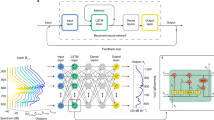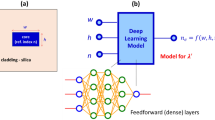Abstract
Physical fields represent quantities that vary in space and/or time axes. Understanding the distribution of a field pattern is a key element in scientific discoveries and technological developments. In this article, by picking up the electromagnetic field of an optical waveguide as an example, we demonstrate how field patterns can be uncovered using artificial neural networks. The cross section plane of the optical waveguide is discretized into a set of tiny pixels, and the field values are obtained at these pixels. Deep learning model is created by assuming the field values as outputs, and the geometrical dimensions of the waveguide as inputs. The correlation between the field values in the adjacent pixels is established by mean of feedback using a recurrent neural network. The trained deep learning model enables field pattern prediction for the entire (and usual) parameter space for applications in the field of photonics.
Access this article
We’re sorry, something doesn't seem to be working properly.
Please try refreshing the page. If that doesn't work, please contact support so we can address the problem.










Similar content being viewed by others
References
Nayak J, Bighnaraj B, Behera HS (2015) A comprehensive survey on support vector machine in data mining tasks: applications and challenges. Int J Database Theory Appl 8:169–186
May A et al (2019) Kernel approximation methods for speech recognition. J Mach Learn Res 20:1–36
Lakin SM et al (2019) Hierarchical hidden Markov models enable accurate and diverse detection of antimicrobial resistance sequences. Commun Biol 2:294
Lee PM (2004) Bayesian statistics: an introduction, 3rd edn. Hodder Education Publishers, London
Battula BP, RamaKrishna KVSS, Kim T (2015) An efficient approach for knowledge discovery in decision trees using inter quartile range transform. Int J Control Autom 8:325–334
Goodfellow I, Bengio Y, Courville A (2016) Deep learning. MIT Press, New York
Sharma N, Jain V, Mishra A (2018) An analysis of convolutional neural networks for image classification. Procedia Comput Sci 132:377–384
Kłosowski P (2018) Deep learning for natural language processing and language modelling. In: Signal processing: algorithms, architectures, arrangements, and applications (SPA), Poznan, pp 223–228
Nassif AB, Shahin I, Attili I, Azzeh M, Shaalan K (2019) Speech recognition using deep neural networks: a systematic review. IEEE Access 7:19143–19165
Pierson HA, Gashler MS (2017) Deep learning in robotics: a review of recent research. Adv Robot 31:821–835
Wang J et al (2018) Deep learning for smart manufacturing: methods and applications. J Manuf Syst 48:144–156
Lavecchia A (2019) Deep learning in drug discovery: opportunities, challenges and future prospects. Drug Discov Today 24:2017–2032
Xue D et al (2016) Accelerated search for materials with targeted properties by adaptive design. Nat Commun 7:11241
Sadowski P et al (2015) Deep learning, dark knowledge, and dark matter. Proc Mach Learn Res 42:81–87
Zhu L et al (2008) Deep learning for seismic phase detection and picking in the aftershock zone of 2008 Mw7.9 Wenchuan earthquake. arXiv:1901.06396
Brunton SL, Noack BR, Koumoutsakos P (2020) Machine learning for fluid mechanics. Annu Rev Fluid Mech 52:477–508
Beerel PA, Pedram M (2018) Opportunities for machine learning in electronic design automation. In: 2018 IEEE international symposium on circuits and systems (ISCAS), Florence, pp 1–5
Landau LD, Lifshitz EM (2015) The classical theory of fields, 4th edn. Butterworth Heinemann Ltd, Oxford
Acheson DJ (1990) Elementary fluid dynamics. Oxford applied mathematics and computing science series. Oxford University Press, Oxford
Griffiths DJ (2017) Introduction to electrodynamics, 4th edn. Cambridge University Press, Cambridge
Turduev M, Bor E, Latifoglu C, Giden IH, Hanay YS, Kurt H (2018) Ultracompact photonic structure design for strong light confinement and coupling into nanowaveguide. J Lightw Technol 36:2812–2819
Malkiel I, Nagler A, Mrejen M, Arieli U, Wolf L, Suchowski H (2017) Deep learning for design and retrieval of nanophotonic structures. arXiv:1702.07949
Ma W, Cheng F, Liu Y (2018) Deep-learning-enabled on-demand design of chiral metamaterials. ACS Nano 12:6326–6334
Liu D, Tan Y, Khoram E, Yu Z (2018) Training deep neural networks for the inverse design of nanophotonic structures. ACS Photonics 5:1365–1369
Alagappan G, Png CE (2019) Deep learning models for effective refractive indices in silicon nitride waveguides. J Opt 21:035801
Alagappan G, Png CE (2018) Modal classification in optical waveguides using deep learning. J Mod Opt 66:557–561
Okamato K (2006) Fundamental of optical waveguides. Elsevier Inc., Amsterdam
Yariv A, Yeh P (2007) Photonics: optical electronics in modern communications. Oxford University Press, Oxford
Gondarenko A, Levy JS, Lipson M (2009) High confinement micron-scale silicon nitride high Q ring resonator. Opt Express 17:11366–11370
Sun X, Alam MZ, Aitchison JS, Mojahedi M (2016) Compact and broadband polarization beam splitter based on a silicon nitride augmented low-index guiding structure. Opt Lett 41:163–166
Chen L, Doerr CR, Chen Y-K (2011) Compact polarization rotator on silicon for polarization-diversified circuits. Opt Lett 36:469–471
Levy JS, Foster MA, Gaeta AL, Lipson M (2011) Harmonic generation in silicon nitride ring resonators. Opt Express 19:11415–11421
Rahman BMA, Fernandez FA, Davies JB (1991) Review of finite element methods for microwave and optical waveguides. Proc IEEE 79:1442–1448
Mabaya N, Lagasse PE, Vandenbulcke P (1981) Finite element analysis waveguides of optical. IEEE Trans Microw Theory Tech 29:600–605
Yu CP, Chang HC (2004) Yee-mesh-based finite difference eigenmode solver with PML absorbing boundary conditions for optical waveguides and photonic crystal fibers. Opt Express 12:6165–6177
Yao K, Unni R, Zheng Y (2019) Intelligent nanophotonics: merging photonics and artificial intelligence at the nanoscale. Nanophotonics 8:339
Peng H-T, Nahmias MA, de Lima TF, Tait AN, Shastri BJ, Prucnal PR (2018) Neuromorphic photonic integrated circuits. IEEE J Sel Top Quantum Electron 24:6101715
Prucnal PR, Shastri BJ (2017) Neuromorphic photonics. CRC Press, Boca Raton
de Lima TF, Shastri BJ, Tait AN, Nahmias MA, Prucnal PR (2017) Progress in neuromorphic photonics. Nanophotonics 6:577
Dory C et al (2019) Inverse-designed diamond photonics. Nat Commun 10:3309
Liu Y et al (2018) Very sharp adiabatic bends based on an inverse design. Opt Lett 43:2482
Zejie Yu, Cui H, Sun X (2017) Genetic-algorithm-optimized wideband on-chip polarization rotator with an ultrasmall footprint. Opt Lett 42:3093–3096
Zhang Y, Yang S, Lim AEJ, Lo GQ, Galland C, Baehr-Jones T, Hochberg M (2013) A compact and low loss Y-junction for submicron silicon waveguide. Opt Express 21:1310–1316
Zejie Yu, Feng A, Xi X, Sun X (2019) Inverse-designed low-loss and wideband polarization-insensitive silicon waveguide crossing. Opt Lett 44:77–80
Ke X, Liu L, Wen X, Sun W, Zhang N, Yi N, Sun S, Xiao S, Song Q (2017) Integrated photonic power divider with arbitrary power ratios. Opt Lett 42:855–858
Lebbe N, Glière A, Hassan K (2019) High-efficiency and broadband photonic polarization rotator based on multilevel shape optimization. Opt Lett 44:1960–1963
Lin Z, Liu V, Pestourie R, Johnson SG (2019) Topology optimization of freeform large-area metasurfaces. Opt Express 27:15765–15775
Logan S, Trivedi R, Sapra NV, Piggott AY, Vercruysse D, Vučković J (2018) Fully-automated optimization of grating couplers. Opt Express 26:4023–4034
Logan S, Piggott AY, Sapra NV, Petykiewicz J, Vučković J (2018) Inverse design and demonstration of a compact on-chip narrowband three-channel wavelength demultiplexer. ACS Photonics 5:301
Piggott A, Lu J, Lagoudakis K, Petykiewicz J, Babinec T, Vuckovic J (2015) Inverse design and demonstration of a compact and broadband on-chip wavelength demultiplexer. Nat Photonics 9:374–377
Hegde RS (2020) Photonics inverse design: pairing deep neural networks with evolutionary algorithms. IEEE J Sel Top Quantum Electron 26:1
Song J, Tokpanov YS, Chen Y, Fleischman D, Fountaine KT, Atwater HA, Yu Y Optimizing photonic nanostructures via multi-fidelity Gaussian processes. arXiv:1811.07707
Garcia-Santiago X et al (2018) Shape design of a reflecting surface using Bayesian optimization. J Phys: Conf Ser 963:012003
Gabr AM, Featherston C, Zhang C, Bonfil C, Zhang Q-J, Smy TJ (2019) Design and optimization of optical passive elements using artificial neural networks. J Opt Soc Am B 36:999–1007
Alagappan G, Png CE (2019) Universal deep learning representation of effective refractive index for photonics channel waveguides. J Opt Soc Am B 36:2636–2642
Hammond AM, Camacho RM (2019) Designing integrated photonic devices using artificial neural networks. Opt Express 27:29620–29638
Hegde RS (2019) Accelerating optics design optimizations with deep learning. Opt Eng 58:065103
Heaton J (2008) Introduction to neural networks for Java, 2nd edn. Heaton Research Inc, Chesterfield
Moller MF (1993) A scaled conjugate gradient algorithm for fast supervised learning. Neural Netw 6:525
Riedmiller M, Braun H (1993) A direct adaptive method for faster backpropagation learning: The RPROP algorithm. In: Proceedings of the IEEE international conference on neural networks, pp 586–591
James G, Witten D, Hastie T, Tibshirani R (2013) An introduction to statistical learning: with applications in R. Springer, New York
Chollet F (2018) Deep learning with python. Manning, New York
https://www.mathworks.com/help/matlab/ref/scatteredinterpolant.html
Chapre S (2016) Numerical methods for engineers, 7th edn. McGraw-Hill, New York
Giacomini R, White H (2006) Test of conditional predictive ability. Econometrica 74(6):1545–1578
Acknowledgements
This work is supported by RGANS1901, “Al-Enabled Electronic-Photonic IC Design”.
Author information
Authors and Affiliations
Corresponding author
Ethics declarations
Conflict of interest
The authors declare that they have no conflict of interest.
Additional information
Publisher's Note
Springer Nature remains neutral with regard to jurisdictional claims in published maps and institutional affiliations.
Rights and permissions
About this article
Cite this article
Alagappan, G., Png, C.E. Prediction of electromagnetic field patterns of optical waveguide using neural network. Neural Comput & Applic 33, 2195–2206 (2021). https://doi.org/10.1007/s00521-020-05061-9
Received:
Accepted:
Published:
Issue Date:
DOI: https://doi.org/10.1007/s00521-020-05061-9




